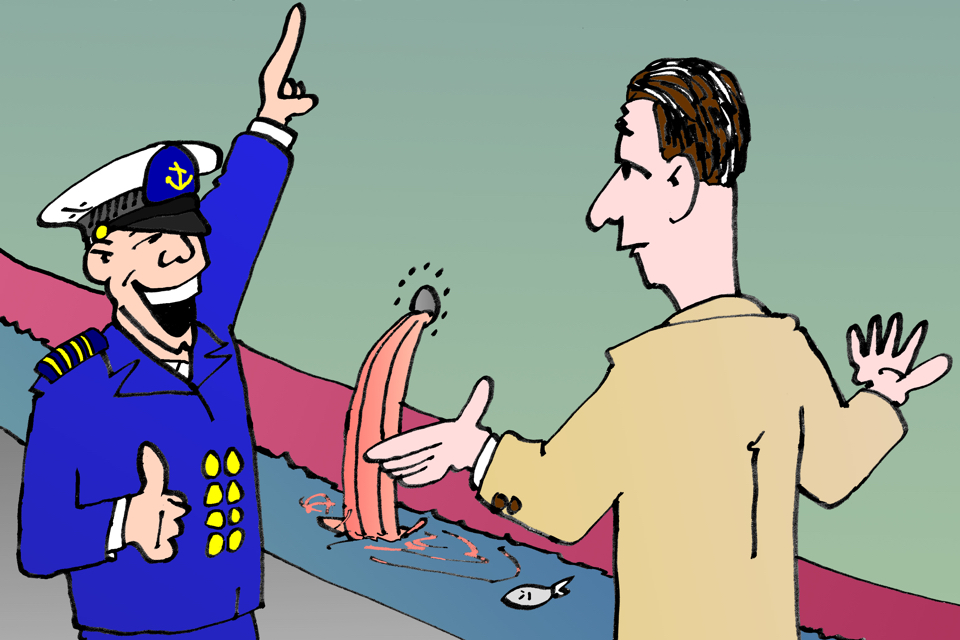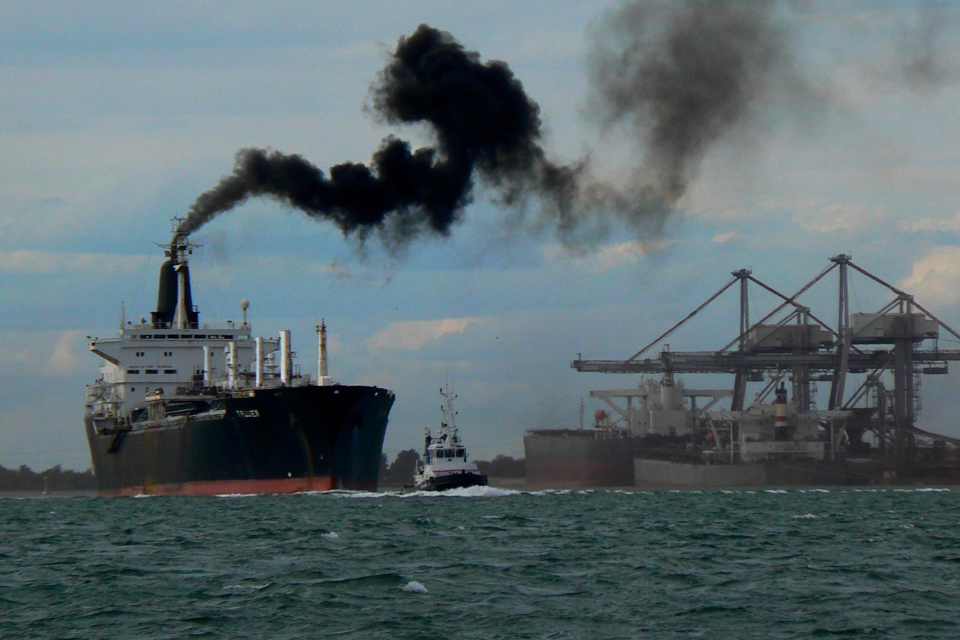There is nothing that currently divides the shipping world so sharply as the scrubber, the internationally widely used term for an exhaust gas cleaning installation. The big question is: How harmful is the waste from these scrubbers that is discharged into the sea?
For a part of the shipowners, albeit still a limited number, it is the solution to be able to comply with the rules for the reduction of sulphur emissions. However, more and more countries are prohibiting their use in their waters.
Scrubbers come in many shapes and sizes, in open and closed systems. In an open-loop system, the exhaust gases are washed with seawater that is discharged. In a closed system, this is done with chemicals, after which the residue is collected in tanks to be delivered to a port for safe processing.
Reducing Health Risks
They were mainly developed by the industry to make emissions from shipping cleaner – that is less harmful to health – even before CO2 emissions were identified as the most important threat to the climate. The use of heavy fuel oil – still a favourite in the shipping industry due to its high energy value – produces a lot of unhealthy substances in the form of soot (fine dust), sulphur and nitrogen when burned.
That is why the International Maritime Organization (IMO) – the UN for international shipping – already adopted an action plan to drastically reduce sulphur emissions from shipping as early as 2005. It was decided that the maximum sulphur content in heavy fuel oil should be reduced from 4.5 to 3.5 per cent by 1 January 2012. In emission control areas (ECAs) such as the coast of the United States, the North Sea, the Baltic Sea and ports, the content was to be reduced from 1.5 to 1 per cent by 2010 and to 0.1 per cent by 2015. Apart from that, the sulphur content of marine fuel is to be reduced from 3.5 to 0.5 per cent by 1 January 2020.
Return on investment of a scrubber takes only a few years
High Uncertainty
This maximum of 0.5 per cent on the oceans and 0.1 per cent in the ECAs means that shipowners are forced to buy low-sulphur fuels for their ships. This could be a distillate such as marine gas oil (MGO), low-sulphur blends (ULSFO) or switching to burning liquefied natural gas (LNG). In those days and until recently, however, there was great uncertainty about the oil industry’s ability to produce sufficient low-sulphur marine fuels.
That is why, in addition to choosing to switch to low-sulphur fuels, shipping was also given the option of installing a system on ships that cleans the exhaust gases to a similar level as those of low-sulphur fuels. The installation of a scrubber on a ship costs between 1.5 and 3 million euros, slightly increases fuel consumption and requires the ship’s engineers to be trained in how to operate it.
The major advantage for shipping, however, is that shipowners can continue to use heavy fuel oil (HSFO = up to 3.5 per cent sulphur) for their ships at any time and anywhere. With the price difference between the cheaper heavy fuel oil and the approximately 1.5 times more expensive low-sulphur marine fuels, return on investment of a scrubber takes only a few years.
The major advantage is that shipowners can continue to use heavy fuel oil for their ships at any time and anywhere
Scrubbers in Shortsea
Nevertheless, orders for the installation of scrubbers were delayed for a long time after 2005. Only when the sulphur emission control areas (SECAs) for the North Sea and the Baltic Sea were established in 2007 and the ECA for the American waters in 2010 did the shipowners become serious about it. For whatever reason, unfamiliarity with the technology, justified or unwarranted fear of the effective operation of scrubbers and the reluctance to invest heavily, many shipowners were deterred from purchasing scrubbers for a long time.
The most important precursor among Dutch shipowners was the Spliethoff Group
But here and there, whether or not convinced by competitive offers, shipowners started experimenting with scrubbers. Not illogical, it was mainly the shipowners who operated their ships in the American and Scandinavian waters who first installed scrubbers. The most important precursor among Dutch shipowners was the Spliethoff Group. This started in 2012 with the installation of scrubbers on the six-unit Timca class of the Finnish shipping company Transfennica, acquired by Spliethoff in 2002.
Shipping Company-wide
The reason for this is that these ships operate mainly in north-western European waters, where the SECA provisions for sailing with low-sulphur fuels are already in force. However, the experiences with the scrubbers on these Transfennicas vessels were so positive that Spliethoff decided in 2014 and ’15 to also equip the fourteen-unit S-class, of 21,000 tonnes carrying capacity and used worldwide, with scrubbers. It has now been decided to provide a further thirty ships of the Spliethoff shipping company and subsidiaries BigLift Shipping and Sevenstar Yacht Transport with scrubbers.
Spliethoff receives the necessary recognition for this, which also translates into hard cash. Earlier this year, it was announced that the ING Bank and the European Investment Bank (EIB) were lending Spliethoff 110 million euros for the purchase of scrubbers and ballast water treatment installations for 42 vessels in the fleet. This loan comes from a 300-million-euro credit facility launched last year that ING and the EIB use to support investments aimed at “greening” the European shipping sector. This allows shipowners to borrow money at an attractively lower interest rate than they would otherwise have lost.
Using scrubbers has translated into hard cash for Spliethoff
Spliethoff as an Advocate
In the meantime, Spliethoff has increasingly come to the fore as an important supporter of the achievements of the scrubber. Last year, Nieuwsblad Transport quoted technical director Arne Hubregtse who noted that thanks to scrubbers and the support of customers, the Spliethoff Group is able to reduce its impact on the environment while at the same time dealing cost-efficiently with the extra burden of the stricter sulphur regulations. He added that Spliethoff ‘as a member of the Trident Alliance, hopes that the authorities will show the same commitment to enforcing the sulphur rules.’
This Trident Alliance is a coalition of more than fifty, mostly large, shipping parties that is committed to strict compliance with the sulphur rules. The underlying aim is to prevent unfair competition from parties that do not take it very seriously.
Scrubber Lobby
In addition, the Spliethoff Group has also joined the Clean Shipping Alliance 2020 (CSA 2020), which specifically promotes the worldwide acceptance of the scrubber as the means to reduce the emission of polluting exhaust gases from shipping. 37 seven members of this organisation are for the most part large (shipping) shipping companies, including not only Spliethoff, but also large ferry operators, such as DFDS and the Grimaldi Group, and Carnival Corporation & PLC, the parent company of nine cruise shipping companies. These shipping companies so far operate some 3000 ships equipped with scrubbers.
The CSA 2020 was awarded the Green4Sea Clean Shipping Award on 12 March in Athens for its important contribution to making shipping cleaner. The vice-chairman of CSA 2020, Star Bulk Carriers manager Charis Plakantonaki, was very pleased with the award.

‘But it is clean up there!’ (by Hans de Wilde/SWZ|Maritime March 2019).
Under Attack
Yet, what is such an award worth now that the scrubber is under attack worldwide? The most common type of scrubber is the so-called open-loop-scrubber. Open-loop because for this scrubber takes in seawater which rinses the exhaust gases. When the water rinses the sulphur dioxide from the gases, bisulphate and silphite are formed, which together can become sulphuric acid. Although seawater has always been acidic because of the salt, the discharge of the washing water from scrubbers can increase the acidity of the seawater.
To what extent do scrubbers strengthen the acidification of the seas and oceans?
The big question now is to what extent the use of scrubbers strengthens the acidification of the seas and oceans. In the middle of the ocean it will not be too bad, but in brackish seas such as the Baltic Sea, the Black Sea, in coastal waters and on busy shipping lanes, this could lead to considerable problems, researchers from the Joint Research Centre, the European Commission’s own research bureau, warned as early as 2016. The seas and oceans are already acidifying due to the increasing emission of the greenhouse gas CO2. On busy shipping routes, however, this acidification could be twice as fast due to sulphur emissions from scrubbers’ washing water.
Sea of Opinions
Meanwhile, everyone is starting to form an opinion about the scrubber. One of the first and most far-reaching was the announcement on 30 November that the port of Singapore will ban the use of open-loop scrubbers in its port by 1 January 2020. China has already banned the use of open-loop scrubbers in its rivers, ports and some coastal waters as of 1 January this year. Norway has banned it from 1 March as well as the ports of Fujairah, Dublin, Waterford and in California and Connecticut. Australia and Panama are considering a ban. Germany, Belgium, Abu Dhabi, Lithuania, Latvia, India and Hawaii have also announced restrictions on the use of scrubbers.
This is a major setback for the shipowners, as it forces them to switch off their expensive scrubber and to store more expensive low-sulphur fuel for their ships. The question is whether the IMO has done everything that was necessary here.
Picture by Roberto Venturini.








